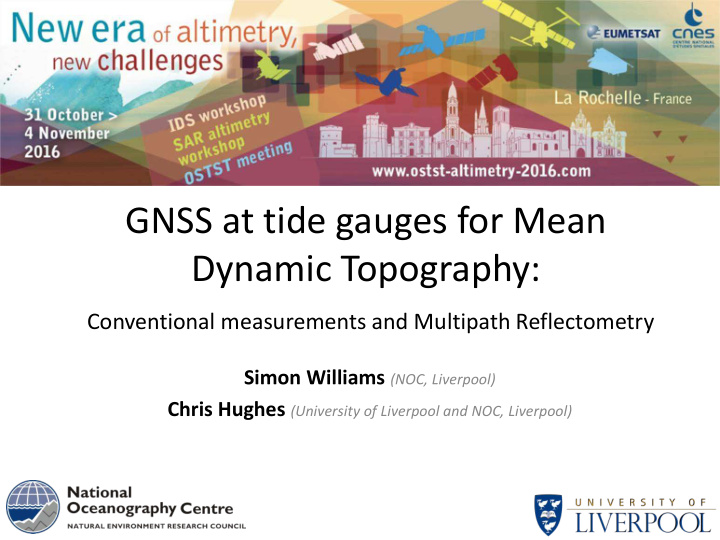



GNSS at tide gauges for Mean Dynamic Topography: Conventional measurements and Multipath Reflectometry Simon Williams (NOC, Liverpool) Chris Hughes (University of Liverpool and NOC, Liverpool)
Mean dynamic topography at tide gauges… why? • Flooding results from sea level at the coast. Only tide gauges measure sea level precisely at the coast. • We want to know whether local dynamics affects sea level significantly, and for long-term prediction (centuries) we want to know whether models can get this right. • The only way to assess the long term is to look at the mean – time series aren’t long enough. GOCE++Dycot Denmark (DTU), France (La Rochelle) Germany (Uni Bonn), UK (Liverpool and Bristol)
Traditional Implementation of a GLOSS CORE Network Site Mean dynamic topography requires: Geoid (GOCE+GRACE+local) • Mean sea level relative to land datum • Height of datum in same reference frame as • the geoid (requires GPS@TG or nearby+levelling)
Most tide gauges do not have GPS ties So far about 280 identified Some have GPS time series, some have only short measurements, for some, the measurement epoch is not known.
Comparing MDT in the N Atlantic and Mediterranean: 113 Tide gauges assorted islands Tide gauge data + GPS position + TUM2013x geoid (i.e. TUM 2013 extended beyond degree 720 using EGM08) Average of NemoQ, Nemo12, and Aviso 2014 MDTs Hughes, C. W., R. J. Bingham, V. Roussenov, Joanne Williams and P. L. Woodworth, 2015: The effect of Mediterranean exchange flow on European time mean sea level. Geophys. Res. Lett. 42 (2), 466-474. doi: 10.1002/2014GL062654.
Root mean square error, as a function of geoid used and model/MDT product. All tide gauges included. Different geoids used at tide gauges Different ocean models (and Aviso dynamic topography product)
Root mean square error, as a function of geoid used and model/MDT product. “Worst” 10 tide gauges missed out. Down to 5-6 cm RMS error (combined error of tide gauges and models)
Preliminary results round Australia (with Mick Filmer, Will Featherstone, Philip Woodworth) So far so good, but this is a long, slow, messy and complicated process. What if we could find a way to shortcut all this combining of information using just GPS, or GPS near TG, without needing a tie? Albany (SW) Darwin Tasmania (SE) Exmouth (NW) Tasmania (SE) Weipa (NE)
GNSS Multipath Reflectometry In the absence of multipath SNR values smoothly rise from ~35 dB to ~52 dB and determined by the satellite transmitted power and the antenna gain pattern Interference between direct and reflected signals causes changes in the signal to noise ratio in the form of periodic signals
Low Tide High Tide Larson, K. M., R. D. Ray, F. G. Nievinski, and J. T. Freymueller (2013), The Accidental Tide Gauge: A GPS Reflection Case Study From Kachemak Bay, Alaska, IEEE Geoscience and Remote Sensing Letters, 10(5), 1200-1204. Oscillations in Signal to Noise have a frequency which tells you height above sea level: GPS=TG
Complications • The measurement is a rate of change with satellite elevation angle. • If sea level is changing during that period, that also has an effect. • Anything else which varies with elevation angle can have a bigger effect than might be expected – including tropospheric delay.
Tropo delay effect can be cm or metres depending on the height above sea level (~ 1%), but can usually be well modelled (these are not the best places, just a variety) Kentucky Santorini (lake) Alaska (Aleutians) Ny-Ålesund Norway Brest (far north) Norway Norway (southern tip) (near Tromsø) Williams, S. D. P. and Nievinski, F. G (2016 submitted) Tropospheric delays in ground-based GNSS Multipath Reflectometry – Experimental evidence from coastal sites, Journal of Geophysical Research – Solid earth
Newlyn M2 Amplitude vs Average Elevation Angle The tropo effect is not just an offset – it is also a scaling of sea level variations
Friday Harbour (near Seattle) Tide gauge and GPS sea level about 30 times per day Larson, K. M., R. D. Ray, and S. D. P. Williams (2016 submitted): A ten-year comparison of water levels measured with a geodetic GPS receiver versus a conventional tide gauge, Journal of Atmospheric and Oceanic Technology .
Daily means RMS difference about 2 cm Spectrum shows very small low 10 years of monthly means frequency errors RMS difference close to 1 cm
Esbjerg, Denmark – more than 12 years of data
Current known GNSS water level sites ~60 − 70 good sites identified so far (only a few processed)
CACC Crescent City, California Testing new methods Tide gauge GPS interferometry Both detided, and using a power spectrum method to identify the frequency of S/N oscillations.
CACC Crescent City, California Testing new methods (L5 signal) Residual ( = error on estimation of tide gauge height from each satellite pass). RMS = 8.6 cm New residual, using nonlinear least squares and known rate of change of sea level from tide gauge, and switching to L5 instead of L1 and L2 RMS = 1.5 cm
Summary • Mean dynamic topography from tide gauges is consistent with ocean models/open ocean MDT at the 5-8 cm RMS level. We suspect that most of this is point geoid error, but some will also be local dynamics. • Collating GPS ties to tide gauges is a slow, tedious process fraught with possible slips. • GPS reflectometry offers a way to sidestep much of this, and to use GPS receivers as tide gauges. • Correcting for tropospheric delay is very important, and can be done accurately. • New analysis techniques offer significant improvements. 1-2 cm RMS is certainly possible, and below 1 cm may be attainable with averaging.
Recommend
More recommend